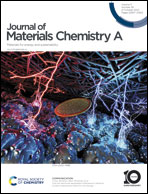Efficient photoelectrocatalytic CO2 reduction to CH3OH via porous g-C3N4 nanosheets modified with cobalt phthalocyanine in ionic liquids†
Abstract
Photocatalytic CO2 reduction into fuels is desirable; however, realizing efficient CnH2n+1OH (n = 1, 2) synthesis that involves electron-coupled proton transfer alongside C–C bond formation remains a challenge. Here, we demonstrated a photoelectrocatalytic (PEC) CO2 reduction strategy to generate CH3OH and CH3CH2OH on cobalt phthalocyanine/g-C3N4 (CoPc/CN) in ionic liquids (ILs). In situ infrared spectroscopy indicated that *HCOO was a key intermediate for the evolution of CH3OH, and density functional theory (DFT) revealed that the Gibbs energy of C–C coupling dropped significantly from 4.94 to 2.21 eV in the ILs electrolyte. The carrier separation efficiency was enhanced in [BMMIm]Br electrolyte, in which photocurrent was 9-fold higher than that in KHCO3. This strategy achieved record-high CH3OH and CH3CH2OH generation abilities (6465.9 and 218.6 μM cm−2 h−1), which were 60.7- and 17.8-fold higher than those in KHCO3, respectively. Therefore, this work develops a PEC strategy to obtain excellent CH3OH yield, and provides new insight into the C–C coupling mechanism in IL-assisted CO2 reduction.

- This article is part of the themed collection: #MyFirstJMCA


 Please wait while we load your content...
Please wait while we load your content...